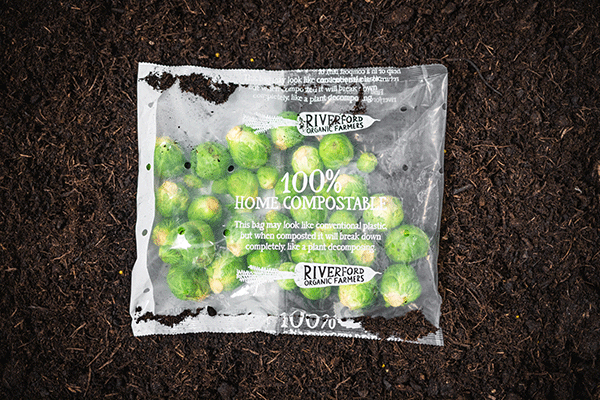With brands trying to reduce single use plastic, there has been a boom in alternative plastics materials. Coffee cup lids, magazine packaging, takeaway boxes and sachets are just a few examples of single-use items that have been produced in plastic alternatives. However, some these are not quite as green as they might first seem.
Home compostable materials
(Example: Riverford’s salad bags, punnets and nets)
Home compostable materials, bearing the seed mark logo, have been certified to breakdown in home composting conditions. Within a year on a compost heap under normal temperatures, the material will break down into water, CO2 and carbon.
How to dispose of home compostable materials? Ideally in your home compost heap. If you don’t compost, check whether your local council will accept it as part of their food waste or green waste collection. Riverford’s new home compostable packaging can be returned to the farm where founder Guy Singh-Watson will compost it and use it to nourish the next year’s vegetables.
For a guide on how to make your own compost, click here.

Compostable materials
(Example: TeaPigs teabags, Vegware takeaway cups)
Certified compostable materials breakdown in industrial composting conditions to water, CO2 and carbon within a year. They won’t breakdown in a home composting heap as they require higher temperatures.
How to dispose of compostable materials? Check whether your local council will accept it as part of their food waste or green waste collection. If not, these materials need to be disposed of as part of your general waste.

Biobased materials
(Examples: Some brands are using bioplastics within their plastic bottles, including Innocent and vitamin water brand Glacéau, both owned by Coca Cola.)
A plastic material where the feedstock used to manufacture the plastic is derived from a renewable source (e.g. maize). A material that is categorised as biobased doesn’t necessarily break down naturally; biobased only refers to what is used to make the material.
How to dispose of biobased materials? If the biobased item doesn’t display any recycling or composting logos, then these materials need to be disposed of as part of your general waste.
Biodegradable materials
(Examples: Can include Vegware PLA (cornstarch) takeaway containers or Natureflex home compostable plastic bags. Paper products are generally biodegradable, and best recycled, as long as they aren’t coated with something or heavily inked.)
A material that will break down by the action of living organisms. The term biodegradable isn’t regulated so there is no defined time period at which this may take place.
How to dispose of biodegradable materials? If the degradable item doesn’t display any recycling or composting logos, then these materials need to be disposed of as part of your general waste.

Degradable materials
(Examples: Supermarket plastic bags)
Degradable refers to any plastics that are designed to degrade under certain environmental conditions. Oxo-degradables specifically need the presence of oxygen to accelerate breakdown, so in an anaerobic landfill would likely remain whole.
How to dispose of degradable materials? These materials need to be disposed of as part of your general waste.












0 Comments